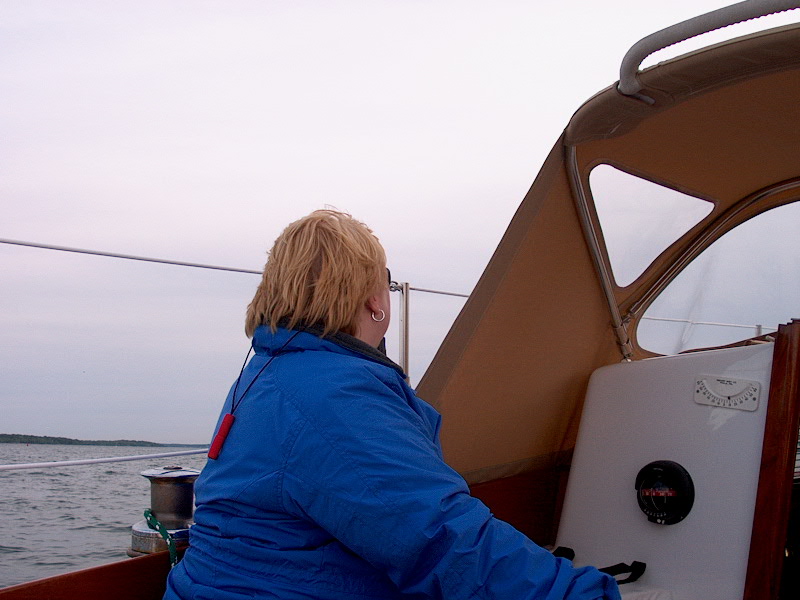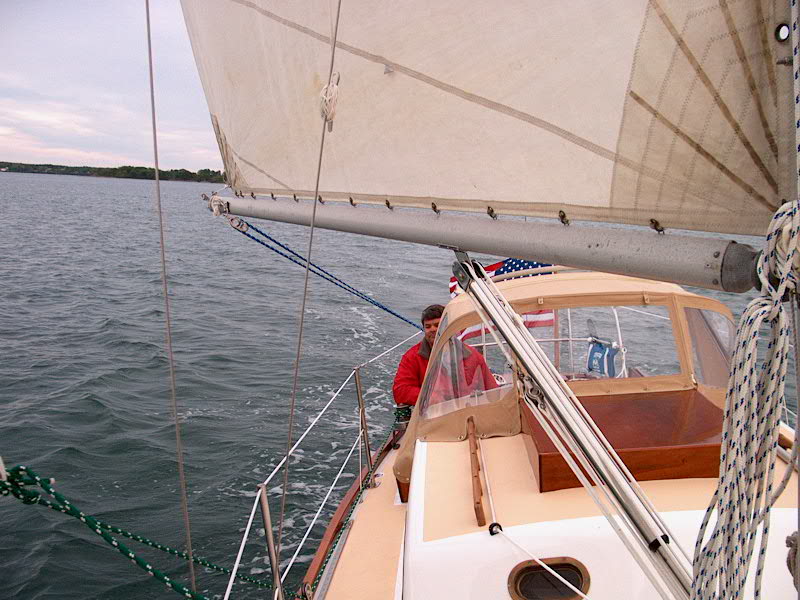|
Log for 1 June 2001--First sail!
Finally, after two weeks of working on the boat in the water
and some frustrating weather delays, we were able to set sail for the first
time. The winds were fairly light, up to about 10 knots or so at the most;
maybe 12. Earlier in the day, I had installed new battens in the
mainsail--there were none when we got it. With this final piece of the
puzzle in place--plus knowing that the engine was finally able to actually be
used--we were finally all set.
We raised the main at the mooring--what a rag! It will
get us through the next couple weeks while we wait for our new one,
however. It is definitely a tired, old-school mainsail with little or no
roach to speak of, no belly or foot adjustment at all, and very soft, worn-out
sailcloth. It's also a little short on the hoist, and the foot is about
16" shorter than the boom--a common modification, I understand. I
prefer sail area myself, so our new main will have the proper foot measurement.
Update: 2008
Yeah, no.
I should have understood
why the original main was 16" short on the foot. As it
turned out, weather helm was a significant issue,
particularly with a full-length foot and oversized roach on
our new main. This meant that we reefed
early--about 15 knots--and dealt with arm-straining weather
helm much of the time, reefed or not.
In addition, the large
roach exacerbated the problem, and also became increasingly
annoying over the years as it caught on the backstay during
each tack. In light winds, it often wouldn't even
cross over the stay, becoming stuck on the top batten.
I got really fed up with this, and threatened repeatedly to
get a new sail. As of this writing, I am going to have
to live with the existing sail for at least another season
or so, but when I get a new one, it will have a standard
roach, and be significantly shorter on the foot to address,
at last, the weather helm issue.
The lesson here is that one
doesn't always know better than those who have been sailing
these boats for years. Watch and learn! |
After dropping the mooring, we were off! The wind at
that moment was quite light, but I was able to fall off and sail around a couple
of nearby moored boats before tacking and heading out of the
anchorage. First impression: the boat sails well with
only the main, even in light winds. That's a plus.
 Once
we tacked, we had a clear shot out of the anchorage, so we unrolled our new
genoa. Very nice! My initial sheet lead position was a little
off--the sail was breaking at the top first, so, with my wife Heidi at the helm,
I moved the block on the windward side a little forward. Later, after a
tack, I changed the other lead as well. The new position seemed to allow
the sail to break evenly along the luff. Once
we tacked, we had a clear shot out of the anchorage, so we unrolled our new
genoa. Very nice! My initial sheet lead position was a little
off--the sail was breaking at the top first, so, with my wife Heidi at the helm,
I moved the block on the windward side a little forward. Later, after a
tack, I changed the other lead as well. The new position seemed to allow
the sail to break evenly along the luff.
I was happy to see that the GPS and our knotmeter agreed
closely on our speed for most of the evening. We easily crept up past 3.5
knots and into the 4 range--not bad at all, I thought, for light winds.
The boat is definitely not a slug--not that I ever thought she would be!
Again, I was most impressed by the motion of the boat through the water--she
feels like a much bigger boat. Very, very nice. Easy to tack the
genoa, too, since the overlap is not too big, and the lack or forward lowers
really does help keep things from binding up as the sail comes across.
 I
played around with the main a little, tweaking my new vang--one of my favorite
new pieces of gear. Too bad the sail didn't have any shape, but that will
soon be taken care of. It was a little surreal actually sailing the boat,
after such a long road to get here. However, I felt my hard work was most
justified by our unfortunately short sail. The boat was impressive.
After a few tacks to windward, we had to think about turning back for the
mooring so we could catch the last launch before 9. We fell off the wind,
and eased the sails. We had an extremely pleasant reach back to the
mooring, and easily picked up the mooring under sail. Who needs engines,
anyway? I
played around with the main a little, tweaking my new vang--one of my favorite
new pieces of gear. Too bad the sail didn't have any shape, but that will
soon be taken care of. It was a little surreal actually sailing the boat,
after such a long road to get here. However, I felt my hard work was most
justified by our unfortunately short sail. The boat was impressive.
After a few tacks to windward, we had to think about turning back for the
mooring so we could catch the last launch before 9. We fell off the wind,
and eased the sails. We had an extremely pleasant reach back to the
mooring, and easily picked up the mooring under sail. Who needs engines,
anyway?
I am thrilled, and can't wait to sail her again.
|

 Once
we tacked, we had a clear shot out of the anchorage, so we unrolled our new
genoa. Very nice! My initial sheet lead position was a little
off--the sail was breaking at the top first, so, with my wife Heidi at the helm,
I moved the block on the windward side a little forward. Later, after a
tack, I changed the other lead as well. The new position seemed to allow
the sail to break evenly along the luff.
Once
we tacked, we had a clear shot out of the anchorage, so we unrolled our new
genoa. Very nice! My initial sheet lead position was a little
off--the sail was breaking at the top first, so, with my wife Heidi at the helm,
I moved the block on the windward side a little forward. Later, after a
tack, I changed the other lead as well. The new position seemed to allow
the sail to break evenly along the luff. I
played around with the main a little, tweaking my new vang--one of my favorite
new pieces of gear. Too bad the sail didn't have any shape, but that will
soon be taken care of. It was a little surreal actually sailing the boat,
after such a long road to get here. However, I felt my hard work was most
justified by our unfortunately short sail. The boat was impressive.
After a few tacks to windward, we had to think about turning back for the
mooring so we could catch the last launch before 9. We fell off the wind,
and eased the sails. We had an extremely pleasant reach back to the
mooring, and easily picked up the mooring under sail. Who needs engines,
anyway?
I
played around with the main a little, tweaking my new vang--one of my favorite
new pieces of gear. Too bad the sail didn't have any shape, but that will
soon be taken care of. It was a little surreal actually sailing the boat,
after such a long road to get here. However, I felt my hard work was most
justified by our unfortunately short sail. The boat was impressive.
After a few tacks to windward, we had to think about turning back for the
mooring so we could catch the last launch before 9. We fell off the wind,
and eased the sails. We had an extremely pleasant reach back to the
mooring, and easily picked up the mooring under sail. Who needs engines,
anyway?